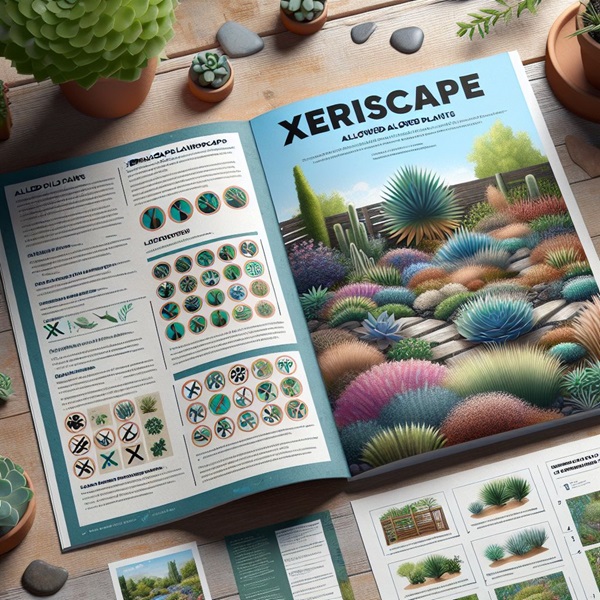
Key Takeaways:
- There are specific Montana state laws that support eco-friendly xeriscaping, even if you face HOA restrictions.
- Xeriscaping in Montana means choosing plants and design elements that are drought-resistant and well-suited to the local climate.
- Understanding your Homeowners Association (HOA) rules is critical before making any changes to your landscape.
- Working with your HOA can lead to a successful xeriscape design that saves water and money while enhancing local biodiversity.
- Regular maintenance and knowledge of approved plants are key to a thriving xeriscape in Montana communities.
Understanding HOA Landscape Guidelines and Deciphering Regulations
Let’s start by navigating the rules. Homeowners Associations can have a lot to say about what you do in your front yard, but in Montana, state laws are on your side. They encourage the use of drought-resistant landscaping, which means you can push for xeriscaping even if your HOA initially seems hesitant. However, the trick is in the approach. You’ll need to understand your HOA’s specific requirements and how to work within them to create a sustainable garden that’s both beautiful and eco-friendly.
Identifying Common Plant Choices in Montana HOAs
Now, onto the plants. Most HOAs have an approved plant list that aligns with the community’s aesthetic. In Montana, this list often includes native species that are naturally drought-resistant and wildlife-friendly. These plants are not just survivors; they’re local champions that require minimal water and maintenance. Here’s a pro tip: by choosing plants from this list, you’re not only complying with HOA guidelines, you’re also contributing to the local ecology.
Navigating the Approval Process for Landscape Changes
When it comes to getting your xeriscaping plan approved by the HOA, preparation is key. You’ll need to present a well-thought-out design that includes plant selections, irrigation methods, and hardscaping elements that meet the association’s guidelines. Most importantly, your plan should clearly demonstrate how it aligns with the principles of water conservation and Montana’s climate. Remember, the goal is to work with the HOA, not against it, so be open to their feedback and ready to make adjustments if needed.
Before we dive deeper into the specifics of xeriscaping in Montana, let’s set the stage with an image that embodies the essence of local xeriscaping. Picture this: the majestic ‘Sea Can Fox’ – a symbol of adaptability and resilience, much like the native plants of Montana’s landscape. With that inspiration in mind, let’s continue our journey towards a more sustainable and visually harmonious garden.
Using Drought-Resistant Plants to Save Water and Money
Choosing the right plants is crucial. In Montana, this means selecting species that can handle the dry summers and cold winters. Drought-resistant plants are not only practical, they’re also cost-effective. They require less water, which means lower utility bills and less time spent on maintenance. Consider native grasses, wildflowers, and shrubs—these plants have evolved to thrive in Montana’s climate and will give your garden a natural, effortless look.
Regular Upkeep to Keep Your Xeriscape Thriving
Regular maintenance is essential for a xeriscape, but don’t worry—it’s less intensive than caring for a traditional lawn. Start with the basics: mulching to retain soil moisture, weeding to reduce competition for water, and pruning to encourage healthy growth. These simple steps will keep your garden looking great and functioning well.
One thing to keep in mind is the changing seasons. As the weather shifts, so will the needs of your xeriscape. In the spring and fall, you may need to do a bit more work to help your plants transition. But come summer, you can sit back and enjoy the fruits of your labor with minimal additional effort.
Another key point is irrigation. Even drought-resistant plants need water to establish themselves. Drip irrigation is a fantastic option for xeriscapes as it delivers water directly to the roots of the plants, reducing waste. Once your plants are established, you’ll find they need very little additional watering, if any at all.
Lastly, remember that xeriscaping is about working with the land, not against it. Pay attention to the natural contours of your property and use them to your advantage. This could mean planting in a way that takes advantage of rainfall patterns or using rocks and hills to create a landscape that’s both beautiful and functional.
Striking a Balance Between Aesthetics and Conservation in Montana
Finding harmony between a garden that looks good and one that’s good for the environment is a challenge worth accepting. In Montana, the key is to blend xeriscaping principles with the natural beauty of the region. This means using materials like local stone and wood, and choosing a color palette that reflects the surrounding landscape. It’s about creating a space that feels like a natural extension of Montana’s wilderness.
Incorporating Native Flora to Enhance Local Biodiversity
Native plants are the superheroes of the xeriscape garden. They’re already perfectly adapted to the local climate, which means they require less water and are more resistant to pests and diseases. By incorporating these plants into your garden, you’re not just making a smart choice for water conservation—you’re also providing a haven for local wildlife.
- Bitterroot (Lewisia rediviva) – Montana’s state flower, thrives in well-drained soils and attracts pollinators.
- Bluebunch wheatgrass (Pseudoroegneria spicata) – A hardy native grass that’s perfect for erosion control.
- Ponderosa Pine (Pinus ponderosa) – Provides excellent shade and habitat for birds.
- Serviceberry (Amelanchier alnifolia) – Offers beautiful spring blossoms and edible berries for wildlife.
- Blanketflower (Gaillardia aristata) – Adds a splash of color and is very drought-tolerant.
When you choose native plants, you’re not only easing your gardening workload but also contributing to the local ecosystem. Birds, bees, and butterflies all benefit from these plants, which in turn helps to pollinate your garden and keep it thriving.
And let’s not forget the visual appeal. Native plants offer a variety of textures and colors that can enhance the aesthetics of your xeriscape. From the silver-green foliage of sagebrush to the vibrant purples of wild lupine, these plants bring the beauty of Montana’s wild spaces right to your doorstep.
Design Tactics That Help Conserve Water and Attract Wildlife
Designing a xeriscape is like painting a picture with plants. You want to use a variety of heights, colors, and textures to create interest. Group plants with similar water needs together to make irrigation more efficient. Use rocks and gravel to add texture and help with water runoff. And don’t forget to include features like bird baths or insect hotels to attract wildlife and bring your garden to life.
One of the most effective design tactics is to create zones in your garden. By zoning, you can place plants with higher water needs closer to your water source and more drought-tolerant plants further away. This not only conserves water but also creates a diverse landscape that’s visually appealing and ecologically sound.

Equipping Homeowners with Resources for Xeriscape Success in Montana
Success in xeriscaping comes with knowledge and support. Luckily, Montana is home to a wealth of resources designed to help gardeners like you succeed. Local workshops, extension services, and gardening clubs are fantastic places to start. They offer advice tailored to Montana’s unique climate and can provide you with the tools you need to create a beautiful, sustainable landscape.
Local Workshops and Extension Services Available in Montana
Montana State University’s Extension Service is a treasure trove of information. They offer workshops on everything from plant selection to pest management, all with the goal of promoting sustainable gardening practices. Local nurseries and garden centers often host classes as well, and these can be great opportunities to connect with fellow garden enthusiasts and share tips and tricks.
Leveraging Community Support for Sustainable Landscaping Practices
Beyond formal resources, don’t underestimate the power of community. Connecting with neighbors who are also interested in xeriscaping can lead to shared knowledge and even shared costs when it comes to buying plants and materials. Social media groups and community boards are great places to find like-minded individuals in your area.
Summary of Requirements in Montana
Table 1: Approved Plants and Landscaping Materials
| Plant/Material | Description |
|---|---|
| Bitterroot | Montana’s state flower, drought-tolerant and attracts pollinators. |
| Bluebunch wheatgrass | A native grass ideal for erosion control and low water use. |
| Ponderosa Pine | A large tree that provides shade and habitat for wildlife. |
| Serviceberry | Produces spring blossoms and edible berries for birds and other wildlife. |
| Blanketflower | A colorful, drought-tolerant flowering plant. |
Table 2: Step-by-Step Xeriscape Plan Submission Guidelines
| Step | Action |
|---|---|
| 1 | Review HOA and local guidelines for landscaping. |
| 2 | Choose plants from the approved list that suit your design and meet xeriscaping principles. |
| 3 | Create a detailed landscape design plan, including plant placement and irrigation strategy. |
| 4 | Submit the plan to your HOA for approval, if required. |
| 5 | Once approved, implement your plan and maintain your xeriscape according to best practices. |
References:
https://gallatincd.org/embrace-montanas-beauty-start-xeriscaping-and-plant-native/
https://www.promontoryhoa.org/xeriscaping/
With these steps and resources, you’re well on your way to creating a xeriscape that will be the envy of your neighborhood and a testament to your commitment to sustainability. Remember, xeriscaping is not only about saving water—it’s about creating a landscape that resonates with the natural beauty of Montana and supports the environment.
Checklist for Xeriscaping in Montana Communities
Transforming your yard into a xeriscape can seem like a daunting task, but with a solid plan and the right information, it’s entirely achievable. Here’s a checklist to keep you on track:
- Understand your local climate and typical weather patterns.
- Research native plants and their water requirements.
- Consult with your HOA and review any landscaping guidelines.
- Design your xeriscape with both aesthetics and water conservation in mind.
- Prepare your soil to ensure it’s ready for drought-tolerant plants.
- Choose an efficient irrigation system, like drip irrigation, to save water.
- Install your plants, grouping them according to their water needs.
- Apply mulch to reduce evaporation and keep the soil moist.
- Maintain your xeriscape regularly to keep it healthy and thriving.
Remember, xeriscaping is more than just planting drought-resistant plants; it’s about creating a sustainable ecosystem that works with your local environment.
Step-by-Step Guidelines for Converting to a Xeriscape
To convert your traditional lawn into a xeriscape, start by removing any turf grass, which typically requires a lot of water. Replace it with a landscape fabric and mulch to prevent weeds and retain soil moisture. Then, introduce native plants that are adapted to Montana’s climate. Plan your garden layout with zones based on water needs, and consider adding a drip irrigation system for efficient watering. Finally, add decorative elements like stones or pavers to create paths and define spaces.
Maintenance Tips for Season-Long Landscape Health
Maintaining your xeriscape is about observing and responding to the needs of your plants and the environment. Here are some tips to keep your xeriscape healthy throughout the seasons:
- Spring: Prune dead or damaged branches, divide perennials if needed, and add compost to give your plants a nutrient boost.
- Summer: Monitor your plants for signs of stress during the hottest months, and water if necessary. Keep mulch levels consistent to conserve moisture.
- Fall: Plant new perennials and shrubs, and consider collecting seeds from annuals for next year. This is also a good time to add mulch to protect plants from the cold.
- Winter: Although your xeriscape requires less maintenance in winter, check for damage from snow or ice, and plan for any changes you might want to make in the spring.
Regularly inspecting your xeriscape and addressing any issues promptly will ensure that your garden remains a vibrant and sustainable part of your home.

Frequently Asked Questions (FAQ)
If you’re considering xeriscaping in a community with an HOA, you likely have questions about what’s allowed and what the benefits are. Here are some common questions and answers to help you navigate the process.
Can HOAs in Montana prohibit xeriscaping in residential landscaping?
No, they can’t. Montana state laws support the practice of xeriscaping. This means that even if your HOA has restrictions, you have the right to use drought-resistant landscaping. However, it’s still important to work with your HOA to ensure your xeriscape meets their aesthetic guidelines.
What are the benefits of xeriscaping in Montana’s climate?
Xeriscaping offers numerous benefits in Montana’s varied climate. It conserves water, which is crucial in areas with limited rainfall. It also requires less maintenance than traditional lawns, saving you time and effort. Additionally, xeriscaping can increase property values by enhancing curb appeal with a well-designed, sustainable landscape.
How does xeriscaping impact local wildlife and ecosystems?
Xeriscaping positively impacts local wildlife and ecosystems by providing habitats for native species. Using plants that are naturally part of the local flora creates a haven for pollinators, birds, and other wildlife, which can help maintain ecological balance and biodiversity.
What are some common misconceptions about xeriscaping?
One common misconception is that xeriscaping means a barren or rock-filled yard. In reality, xeriscaping can be lush and vibrant, filled with a variety of plants that offer year-round interest. Another myth is that xeriscaping is ‘no maintenance.’ While it’s low maintenance, it does require some care, especially when plants are young and establishing themselves.
Where can I find a list of plants approved for xeriscaping in Montana?
You can find a list of approved plants for xeriscaping in Montana through local extension services, nurseries specializing in native plants, or by consulting with a local landscape architect or xeriscaping expert. Additionally, the Montana Native Plant Society provides resources for selecting native plants suited to xeriscaping.
In conclusion, xeriscaping in Montana is a rewarding venture that can lead to a beautiful, eco-friendly landscape that aligns with your HOA’s guidelines. By understanding the regulations, choosing the right plants, and maintaining your xeriscape, you can create an outdoor space that saves water, supports local ecosystems, and provides a serene environment for you to enjoy. Remember, xeriscaping is not just about the plants you choose; it’s about creating a sustainable, harmonious landscape that reflects the natural beauty of Montana.




Leave a Reply